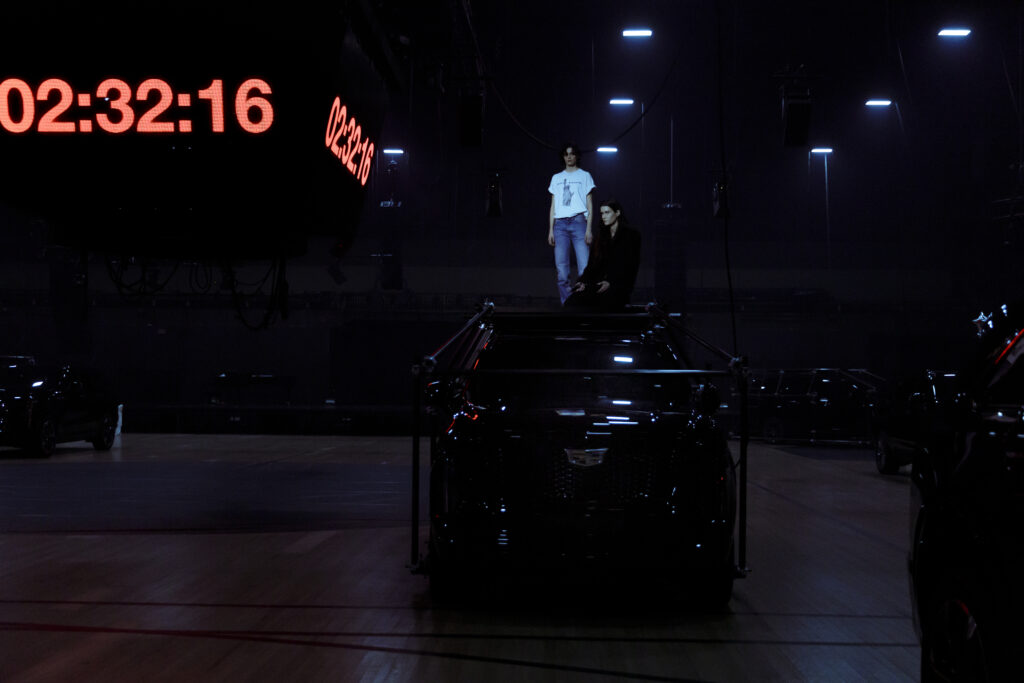Anne Imhof’s Expertise Present

Sihana Shalaj and Eliza Douglas in DOOM. {Photograph} by Nadine Fraczkowski. Courtesy of the artist, Galerie Buchholz, Sprüth Magers, and Park Avenue Armory.
Anne Imhof’s DOOM: Home of Hope, a three-hour, influencer-studded “blockbuster” efficiency of Romeo and Juliet, presents a variation on the expertise present extra akin to a expertise scenario. Imhof invents a world by which inventive expertise would possibly emanate at any second, unprompted, from the ranks of a psychically bonded skater mob. Staged round a cavalcade of Cadillac Escalades parked at random diagonals throughout the Park Avenue Armory’s fifty-five-thousand-square-foot hangar, the present started with a wolf’s howl ringing out from the darkness. The Jumbotron suspended overhead began counting down from 3:00:00, instilling a Starvation Video games–esque sense of urgency whereas a crew of youths, their garments emblazoned with DOOM in varsity lettering, trickled in to mount the industrial-beam platforms hooked up to the Escalades. Projecting defiance or disaffection, the actors stared down at us, pantomiming tears trailing down their cheeks.
Lastly, the steel gate across the periphery was lowered, and we have been free to infiltrate the scene.
Cool youngsters frequently forked off from the clique to launch into choreographed performances, recitations of discovered texts, or miscellaneous scenes from Shakespeare’s play. Their blocking traversed the Escalades, a number of typical phases, a semi-secluded white room, and the spotlit middle courtroom. The viewers was left to roam the hangar however typically gravitated towards the transferring middle of curiosity. Extra intimate moments, like monologues or the dripping of candle wax on bare pores and skin, have been filmed on a cellphone and broadcast in actual time on the Jumbotron. In the meantime, background gamers stored on gesticulating from the automotive phases, covertly making out or tattooing each other within the trunks.
My favourite second was an eloquent speech by a pianist character concerning the feat of writing about efficiency from reminiscence. Within the carnivalesque Home of Hope, all skills are honored, even the critic’s! I felt seen. Studying the playbill later, I realized that her speech comprised excerpts from well-known critics’ obituaries, and the nice and cozy feeling pale. The quantity of skills on show (rapping, calligraphic pores and skin ornament, contortionism, poetry, ballet, industry-plant rock and roll) gave the present a persistently excessive leisure worth. But DOOM by no means felt as sprawling or multifarious because the format may need allowed. The viewers was by no means aggressively divided or engaged with immediately (no Sleep No Extra–type kisses on the mouth). Nobody knew if it was passé to clap after the musical acts.
And the Romeo and Juliet reenactments felt like unmetabolized content material inside the present’s multimedia gestalt. Shakespeare’s drama was on this occasion presubjectively subtle—a lot of the leads are double- or triple-cast. There’s a dancer Romeo and an actor Romeo, singing and skating Tybalts, and so forth. Nothing fairly gels, and we’re left with a random smattering of horseplay battle sequences and the sunshine pathos of Tybalt’s still-vaping “corpse.” If there are warring factions within the Home of Hope, it’s the choreographed skater clique versus the disoriented viewers.
DOOM: Home of Hope’s mash-up of skills and literary allusions was clearly developed in collaboration with the high-profile solid. However not like most efficiency artists working within the collaborative vein, Imhof isn’t anti-object. DOOM as an alternative elevates artifacts of the current, showcasing the shiny, streamlined commodities—UberXLs, telephones, vapes, glitter belts—that kind our denuded monoculture. When Imhof pairs these objects with highly effective affective forces like skater coolness/affect and haptic bass tones, it looks like she’s mobilizing all the pieces we’ve obtained in 2025 (with the merciful exception of memes).
What can we surmise from this daring collage of the current? This aspiration to mythic stability in an more and more contingent good world is echoed within the monolithic (actually, black shiny slab) aesthetics of the objects themselves—it functioned properly as a bit of design criticism.
Outdoors the Armory after the present, I requested my mates if I’d missed something whereas I used to be resting, wearily, within the Mylar-balloon-centerpiece Bar Mitzvah desk part. Apparently, at one level, a lady had chained herself to one of many Escalades, declaring, “SUVs don’t have any place in artwork.” Whether or not this was part of the efficiency or a protestor’s intervention is anybody’s guess, though the specific environmentalist sentiment appears incongruous with Imhof’s tone. Within the Bush period, SUVs have been a go-to image of gas-guzzling hubris, however in DOOM they felt purely architectural, affording visually attention-grabbing stage shifts paying homage to Shakespeare’s balcony sequence. The specter of (titular) local weather doomerism haunts DOOM, however it’s repressed into simplistic schoolyard chants of “DOOM!”/“HOPE!”/“DOOM!”/“HOPE!” Our ecological future is a subject artwork appears ill-equipped to cope with. Lowering doomerism to white noise shouldn’t be the proper method, however I’m undecided what could be.

0 Comment